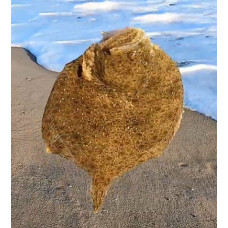Latin name
Scophthalmus maeoticus
Other names
Kalkan, Scophthalmus maeoticus.
Identification
The body is tall, 80% of its length (the body height is almost equal to the length or even more), covered with bony conical tubercles. The eyes are on the left (upper) side. The underside (right side) of the fish is white, the eye side is brownish with reddish spots. The Black Sea turbot has no scales. The fish also has the ability to change colour depending on the colour of the bottom for camouflage. The jaws are armed with smooth, bristle-like teeth arranged in bands, and there are also teeth on the mouth opener.
Distribution
It is found only in the Black Sea, the Sea of Azov and the adjacent part of the Sea of Marmara; it enters the mouths of the Dnieper and Dniester rivers.
Habitat
It prefers sandy (shell) and muddy soils and can be found at depths of over 100 metres.
Size
The maximum length is 85 cm and the mass is 12-16 kg.
Life history and Behavior
Juveniles appear in August in the benthic layer at depths of 2-10 m, where they remain for two to three months. Juveniles then move away from the shore. Adults (4-7 years old) concentrate on spawning at depths of 30-70 m in early spring, move to deeper water in July-August, and return to the coast to feed in October. In summer, quite large juveniles can be seen on the bottom right in the beach zone of the Azov and Black Seas.
Food and feeding habits
A predatory fish. It feeds on small fish, small crustaceans and molluscs. Adults feed mainly on demersal fish and crustaceans: red mullet, hamsa, horse mackerel, Black Sea haddock, Black Sea sprat, herring; juveniles feed mainly on crustaceans. Adult fish eat at least 150 g of fish per day.
Reproduction
Males usually reach sexual maturity at 5-8 years, females at 6-11 years. Breeds in the open sea at a depth of 25-70 m, at a temperature of 8-12 °C, from the end of March-April until the second half of June, in some places until the end of July. Spawning peak in May. Breeds from 2.5 to 13 million eggs. It is the most fertile fish in the Black Sea. High fecundity can compensate for the loss of eggs and larvae to predators and unfavourable natural conditions. Eggs are spherical transparent bodies 1.1-1.28 mm in diameter with a small fat droplet 0.17-0.21 mm in diameter. Eggs are buoyant and stay close to the surface in seawater. Ichthyologists find from 1-2 to 8-10 eggs in 1 m³ of water. Eggs are dispersed over a wide area by currents, so that if an area of coastal waters is under the influence of unfavourable natural or anthropogenic factors (e.g. pollution), not all the eggs of an individual will die. Most of the eggs are eaten by marine organisms that feed on zooplankton. As a result, no more than 500,000 eggs produce no more than 500 larvae. For the first 3-4 days of life, they retain the yolk sac. At the age of 4-5 days, the larvae form a mouth, but they still have poor vision and move very slowly. During this period, called the critical period, 20-25 out of 500 larvae survive. The rest are killed by predators and starvation. 15 to 20 days after the eggs hatch, the larvae become fry and settle on the bottom. By autumn, 5-6 juveniles with a body length of 6-7 cm have survived. In spring, the yearlings return to the coastal zone. Their length is about 10 cm and in autumn they reach 14-16 cm. The main food consists of demersal fish, crustaceans and some molluscs. At this age they have practically no enemies, except the spiny dogfish. The second hibernation takes place at depths of 40-50 metres. In the spring it reaches a body length of 18-20 cm and returns to the coastal zone. At the age of 4 years it reaches a body length of 30-35 cm. At this age some individuals begin to spawn. Overwinters at depths of up to 110 metres.
| Classification | |
| Phylum | Chordata |
| Class | Actinopterygii |
| Squad | Pleuronectiformes |
| Family | Scophthalmidae |
| Genus | Scophthalmus |
| Species | S. maeoticus |
| Features | |
| Conservation status | No information |
| Habitat | Bottom |
| Life span, years | No information |
| Maximum body weight, kg | 16 |
| Maximum length, cm | 85 |
| Sailing speed, m/s | No information |
| Threat to people | Edible |
| Way of eating | Predator |
Black Sea turbot
Tags: black sea turbot


